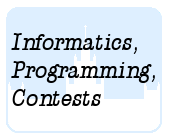Подразделы
Другие разделы
| 2149. Наследство |
| 2150. ДНК |
| 2151. Sumo |
| 2152. Tires |
| 2154. Race |
Дата и время
30/12/2025 00:16:25
 2153. Candies
2153. Candies
 Candies
Candies
 Сокращение перебора с помощью идеи
Сокращение перебора с помощью идеиВыявление особых точек
Олимпиадные задачи на английском языке

| 23/07/2014 | Лето 2014 - 17 (E) |
Ограничения: время – 2s/4s, память – 256MiB Ввод: input.txt или стандартный ввод Вывод: output.txt или стандартный вывод 
Послать решение Blockly Посылки Темы Где Обсудить (0)
Mirko is a party animal, so he has decided to organise an endless amount of parties for his friends. To
satisfy the party's needs, he has decided to set up N tables with candy on them. We know the number
of candies `b_i` on each table. On the first day of the rest of eternity, Mirko is going to invite one friend
per table, on the second day he will invite two friends per table, on the third day three friends… In
general, obviously, on the `k`th day he is going to invite `k`friends per each table.
When his friends enter the room, `k` people will sit down at each table and they will divide the candies
on their table in `k` as large as possible equal pieces, and get rid of the possible remains. After the
candy division, because of jealousy and various other reasons, only tables with the same amount of
candy per capita will socialise together. Mirko has all eternity to study the social dynamics of his
parties. Firstly, he wants to know the answer to the following question: given an s between 1 and `N`,
what is the earliest day when there is a group of exactly `s` tables socialising together?
As usual, Mirko is incapable of solving his own problems, so every few days he comes to you and asks
you what the required number is, given an s. Alas, he has all eternity to ask questions, but you don't.
Therefore, you are going to write a programme which outputs Mirko's required answers for each `s`
from 1 to `N`.
Please note: Before each party, Mirko renews the candy supply on each table, meaning the supplies are
equal to those before the first party. Additionally, all people leave from the current party before the
next one starts.
The first line of input contains the integer `N` (`1\ ≤\ N\ ≤\ 100`).
The second line of input contains `N` integers, the `i`th number marking the number of candy on the `i`th
table. The numbers are from the interval `[1,\ 10^8]`.
Output `N` lines, each line containing a single integer.
The `s`th line should contain the required number for a group sized `s` or –1 if there will never be a group
of that size.
Sample Input #1
5 11 10 9 6 4
Sample Output #1
1 2 3 6 12
Sample Input #2
3 5 5 5
Sample Output #2
-1 -1 1
Sample Input #3
8 12 16 95 96 138 56 205 84
Sample Output #3
1 5 14 49 96 97 139 206
Clarification of the first example: On the first day, each table will socialise only with itself so the
answer for groups sized 1 is 1. Already on the second day, people sitting at tables 1 and 2 are going to
get 5 candies per capita and socialise together, so the answer for a group sized 2 is 2.
On the third day, tables 1, 2 and 3 will socialise (because they all have 3 candies per capita).
On the sixth day, tables 1, 2, 3 and 4 will socialise (because they now have 1 candy per capita).
Finally, on the twelfth day, all tables will socialise together because they will all get zero candy per capita.
Clarification of the second example: All tables have the same amount of candy per capita, so a group
sized less than 3 will never exist.
Source: COCI 2013/2014, contest #4
 Начало
Начало